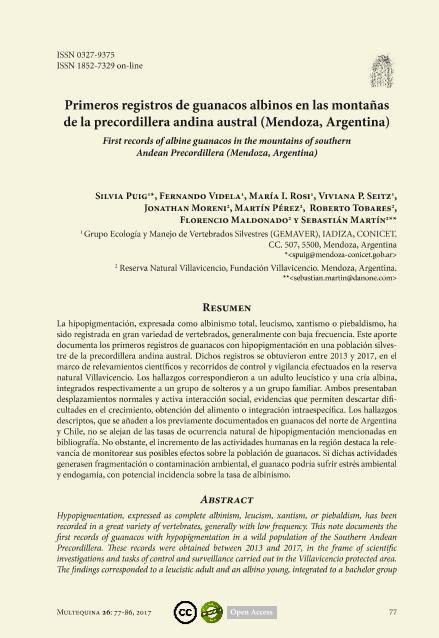Artículo
La hipopigmentación, expresada como albinismo total, leucismo, xantismo o piebaldismo, ha sido registrada en gran variedad de vertebrados, generalmente con baja frecuencia. Este aporte documenta los primeros registros de guanacos con hipopigmentación en una población silvestre de la precordillera andina austral. Dichos registros se obtuvieron entre 2013 y 2017, en el marco de relevamientos científicos y recorridos de control y vigilancia efectuados en la reserva natural Villavicencio. Los hallazgos correspondieron a un adulto leucístico y una cría albina, integrados respectivamente a un grupo de solteros y a un grupo familiar. Ambos presentaban desplazamientos normales y activa interacción social, evidencias que permiten descartar dificultades en el crecimiento, obtención del alimento o integración intraespecífica. Los hallazgos descriptos, que se añaden a los previamente documentados en guanacos del norte de Argentina y Chile, no se alejan de las tasas de ocurrencia natural de hipopigmentación mencionadas en bibliografía. No obstante, el incremento de las actividades humanas en la región destaca la relevancia de monitorear sus posibles efectos sobre la población de guanacos. Si dichas actividades generasen fragmentación o contaminación ambiental, el guanaco podría sufrir estrés ambiental y endogamia, con potencial incidencia sobre la tasa de albinismo. Hypopigmentation, expressed as complete albinism, leucism, xantism, or piebaldism, has been recorded in a great variety of vertebrates, generally with low frequency. This note documents the first records of guanacos with hypopigmentation in a wild population of the Southern Andean Precordillera. These records were obtained between 2013 and 2017, in the frame of scientific investigations and tasks of control and surveillance carried out in the Villavicencio protected area. The findings corresponded to a leucistic adult and an albino young, integrated to a bachelor group and a familial group, respectively. Both showed normal movements and active social interaction, evidences that allow to discard difficulties in growing, obtaining food or intraspecific integration. The described findings, together with those previously documented for the guanaco in northern Argentina and Chile, are not far from the rates of natural occurence of hypopigmentation mentioned in bibliography. However, the increase of human activities in the region highlights the relevance of monitoring their effects on the guanaco population. If such activities generate environmental fragmentation or contamination, the guanaco could present environmental stress and endogamy, with potential incidence on the albinism rate.
Primeros registros de guanacos albinos en las montañas de la precordillera andina austral (Mendoza, Argentina)
Título:
First records of albine guanacos in the mountains of southern Andean Precordillera (Mendoza, Argentina)
Puig, Silvia ; Videla, Fernando
; Videla, Fernando ; Rosi, Maria Irene
; Rosi, Maria Irene ; Seitz, Viviana Paola
; Seitz, Viviana Paola ; Moreni, Jonathan; Pérez, Martín; Tobares, Roberto; Maldonado, Florencia; Martín, Sebastián
; Moreni, Jonathan; Pérez, Martín; Tobares, Roberto; Maldonado, Florencia; Martín, Sebastián
 ; Videla, Fernando
; Videla, Fernando ; Rosi, Maria Irene
; Rosi, Maria Irene ; Seitz, Viviana Paola
; Seitz, Viviana Paola ; Moreni, Jonathan; Pérez, Martín; Tobares, Roberto; Maldonado, Florencia; Martín, Sebastián
; Moreni, Jonathan; Pérez, Martín; Tobares, Roberto; Maldonado, Florencia; Martín, Sebastián
Fecha de publicación:
06/2017
Editorial:
Instituto Argentino de Investigaciones de las Zonas Áridas
Revista:
Multequina
ISSN:
0327-9375
e-ISSN:
1852-7329
Idioma:
Español
Tipo de recurso:
Artículo publicado
Clasificación temática:
Resumen
Palabras clave:
Camelidae
,
Hipopigmentación
,
Lama Guanicoe
,
Precordillera de Los Andes
Archivos asociados
Licencia
Identificadores
Colecciones
Articulos(IADIZA)
Articulos de INST. ARG DE INVEST. DE LAS ZONAS ARIDAS
Articulos de INST. ARG DE INVEST. DE LAS ZONAS ARIDAS
Citación
Puig, Silvia; Videla, Fernando; Rosi, Maria Irene; Seitz, Viviana Paola; Moreni, Jonathan; et al.; Primeros registros de guanacos albinos en las montañas de la precordillera andina austral (Mendoza, Argentina); Instituto Argentino de Investigaciones de las Zonas Áridas; Multequina; 16; 6-2017; 77-86
Compartir



